

The government just admitted it will use smart home devices for spying. If you want evidence that US intelligence agencies aren’t losing surveillance abilities because of the rising use of encryption by tech companies, look no further than the testimony on Tuesday by the director of national intelligence, James Clapper.
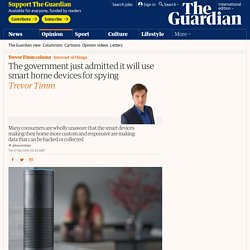
As the Guardian reported, Clapper made clear that the internet of things – the many devices like thermostats, cameras and other appliances that are increasingly connected to the internet – are providing ample opportunity for intelligence agencies to spy on targets, and possibly the masses. And it’s a danger that many consumers who buy these products may be wholly unaware of. “In the future, intelligence services might use the [internet of things] for identification, surveillance, monitoring, location tracking, and targeting for recruitment, or to gain access to networks or user credentials,” Clapper told a Senate panel as part of his annual “assessment of threats” against the US.
Wearable cameras. Security - Botnet - DDoS attack - Wearables. IoT in healthcare. Smart TV. Smart bulbs. Smart meter. Connected toys. Fridge ordering your milk. Internet of Things. Get lost, Alexa: most Britons shun digital assistants over spying fears. S Use of Your Data. Circle City Con 50 108 IoT 4n6 The Growing Impact of the Internet of Things on Digital Forensics Jes.
Defining and securing the Internet of Things: ENISA publishes a study on how to face cyber threats in critical information infrastructures. The study which is titled ‘Baseline Security Recommendations for Internet of Things in the context of critical information infrastructures’, aims to set the scene for IoT security in Europe.
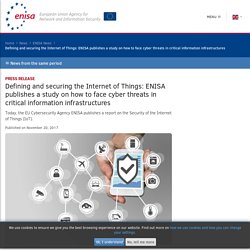
It serves as a reference point in this field and as a foundation for relevant forthcoming initiatives and developments. The ENISA report was developed in cooperation with the ENISA IoT Security Experts Group and additional key stakeholders. Security recommendations crucial for functionality ENISA defines IoT as “a cyber-physical ecosystem of interconnected sensors and actuators, which enables intelligent decision making”.
IoT brings the smart element into every life aspect of Europeans, from smart cars and wearables to smart grids and infrastructures. “The deployment of IoT will be key to our smart cities, smart airports, smart health and smart X. Extremely complex landscape With a great impact on citizens’ safety, security and privacy, the IoT threat landscape is extremely complex. Specifio. La Privacy by Design appliquée aux Objets Connectés : vers une régulation efficiente du risque informationnel ? Consacrant un principe de prévention à la charge des opérateurs, la Privacy by Design est une voie féconde pour gérer le risque informationnel consubstantiel au développement du marché des objets connectés.

Cette méthode, désormais promue par le RGPD, doit être précisée afin de concilier protection et innovation. Une cinquantaine de milliards d’objets devraient être connectés dans le monde à court terme qui permettront de recueillir des données ensuite transmises à un équipement électronique pour piloter une application, traiter ces données corrélées et proposer un produit ou un service adapté. Ces Objets Connectés offrent des opportunités sans précédent pour l’individu dès lors qu’ils visent à lui proposer, grâce aux données qu’ils captent et transmettent, de nouveaux services innovants. La promotion de la PbD s’explique par différents facteurs. EUROPE: Upcoming European Internet of Things rules - Privacy Matters.
The Internet of Things (IoT) is getting regulated through the draft European ePrivacy privacy regulation and the revised database and product liability directives, but is this good news?

I am generally of the opinion that “no rules are better than bad rules“. Regulations can help to foster a market, but if they just create additional obligations, they are likely to damage it.. There is no doubt that the current scenario of uncertainty as to the applicable rights and obligations might be great for lawyers, but companies that need to invest in the IoT would rather have a scenario which is “crystal clear“. The challenge is to see whether European regulators will be able to identify the right balance between regulating and over regulating.
The broad approach of the draft European ePrivacy regulation to the Internet of Things The proposal for the ePrivacy Regulation has now been published and when it comes to Internet of Things technologies the principle is very broad: 1. Enjeux et réalités juridiques des Objets Connectés. It's time for a common sense security framework - Help Net Security.
Privacy Rights Clearinghouse maintains a database of every data breach made public since 2005, and as the total number of records rapidly approaches one billion, board members, infosec leaders, and consumers are all asking the same question: Why does this keep happening?
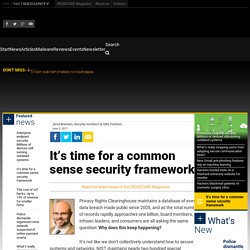
It’s not like we don’t collectively understand how to secure our systems and networks. NIST maintains nearly two hundred special publications focused on computer security, and the ISO 27000 series contains dozens of standards for securing information systems. What’s more, multiple industries have specific standards and regulations targeting information security and risk management controls.
Retail has PCI. Healthcare has HIPAA. Still, the question remains: Why does this keep happening? How Telefonica Is Using IoT And Big Data To Build Smart Cities. Miele's networked disinfecting hospital dishwasher has a gaping security flaw... The Miele PG 8528 is a "washer-disinfector" intended for hospitals and other locations with potentially dangerous pathogens on their dirty dishes; it's networked and smart.
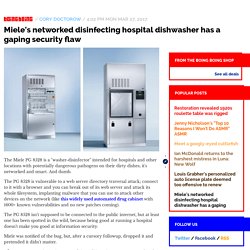
And dumb. The PG 8528 is vulnerable to a web server directory traversal attack; connect to it with a browser and you can break out of its web server and attack its whole filesystem, implanting malware that you can use to attack other devices on the network (like this widely used automated drug cabinet with 1600+ known vulnerabilities and no new patches coming). The PG 8528 isn't supposed to be connected to the public internet, but at least one has been spotted in the wild, because being good at running a hospital doesn't make you good at information security.
Miele was notified of the bug, but, after a cursory followup, dropped it and pretended it didn't matter. 10 Smart Accessories for Your Car. Scmagazine.stfi. The fact that U.S. intelligence agencies have the ability to use connected devices as spy tools may or may not be surprising, depending on one's level of cynicism.
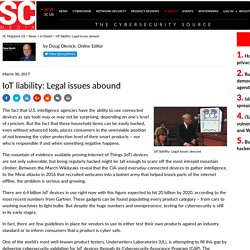
But the fact that these household items can be easily hacked, even without advanced tools, places consumers in the unenviable position of not knowing the cyber protection level of their smart products – nor who is responsible if and when something negative happens. The mountain of evidence available proving Internet of Things (IoT) devices are not only vulnerable, but being regularly hacked might be tall enough to scare off the most intrepid mountain climber. Between the March WikiLeaks reveal that the CIA used everyday-connected devices to gather intelligence, to the Mirai attacks in 2016 that recruited webcams into a botnet army that helped knock parts of the internet offline, the problem is serious and growing.
“The U.S. However, there are a great many regulations on the books by which manufacturers must abide. IoT Application Using Watson IoT & IBM Blockchain. The Internet of Things (IoT) has opened up countless opportunities for businesses to drive smarter operations.
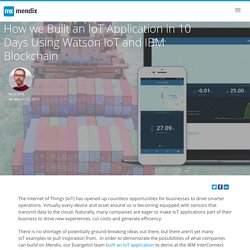
Virtually every device and asset around us is becoming equipped with sensors that transmit data to the cloud. Naturally, many companies are eager to make IoT applications part of their business to drive new experiences, cut costs and generate efficiency. L’internet des objets : la 3ème révolution informatique – 27 avril 2017. Leave a bad review? This IoT garage door opener maker may brick your device.
The maker of an Internet of Things (IoT) garage door opener bricked a customer's device after they posted a negative review on the product's forum board.

First a little background. In the spotlight is a device known as Garadget. According to its Indiegogo page, Garadget communicates with its cloud server via a user's Wi-Fi network. It attaches to the bottom of a regular garage door opener. From this position, it can supposedly open and close a garage door when a user issues a command using the corresponding Android or iOS app by beaming a laser off a reflective pad. Here's a promo for the device: Smart TVs, Microwaves: Stop Hackers From Spying On You. From televisions to toasters, all kinds of devices are getting hooked up to the Internet.
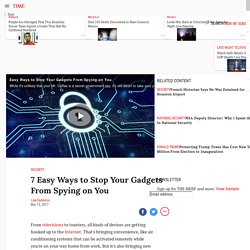
That's bringing convenience, like air conditioning systems that can be activated remotely while you're on your way home from work. But it's also bringing new privacy concerns, as anything connected to the Internet tends to attract the attention of hackers. Case in point: Documents recently released by Wikileaks suggest the Central Intelligence Agency can use spying targets' TVs against them, turning the sets into always-listening microphones.
Kellyanne Conway, counselor to President Donald Trump, also recently claimed that microwaves could also be used as spying devices, though she has since walked back those comments. Other "smart" devices, meanwhile, have been caught secretly tracking their users' behavior and reporting that information back to the company that made them. Insurers must tread very carefully when using private data from wearables. Wearable technology is increasingly recognised as a means to deliver a wide range of benefits to businesses. Recently, insurance providers have recognised ways of using data generated from wearable technology to balance risk, by identifying safe driving behaviour, as well as dangerous practices such as using a mobile phone while at the wheel. However, the information generated by wearable technology includes personal data, the use of which is rapidly becoming a heavily regulated activity, with severe penalties for non-compliant operators.
Insurers that may be considering using personal data collected from wearable technology should recognise that the legal risk they may inadvertently assume potentially dwarfs any benefits. What is wearable tech? The term 'wearable technology' covers a broad range of devices from smart watches to fitness monitors, and virtual reality headsets. Potential use in the insurance sector The legal landscape. Le fil. 185,000+ IoT security cameras are vulnerable to a new worm. Persirai is a new strain of Internet of Things malware that infects more than 1,250 models of security camera, all manufactured by an unnamed Chinese manufacturer that has sold at least 185,000 units worldwide. The vulnerability the malware exploits was discovered and documented by Pierre Kim, an independent security researcher, who has located at least 185,000 vulnerable devices using the Shodan search engine.
The cameras all try to tunnel out of their local firewalls by sending unencrypted data over UDP -- a cousin to TCP -- leaving them vulnerable to hijacking. Once compromised, the cameras can be used to direct devastating, unstoppable floods of traffic to bring down web sites, and can also be remotely monitored by voyeurs, burglars, and other malefactors. Announcing A New Open-Source Privacy Standard For The Internet Of Things – Co... At Consumerist, consumer privacy and data security have been growing areas of coverage over the past few years. We regularly write about policies, corporate and government alike, that either threaten or help safeguard your privacy. We cover data breaches big and small, and investigate tips from you, our readers. L’Internet des Objets un formidable levier business pour les entreprises.
Avec Internet, 7 milliards de personnes peuvent communiquer, échanger des informations, accéder à des services, s’ils disposent de l’énergie et des outils pour pouvoir le faire. En connectant les machines et les objets se sont des dizaines de milliards d’entités qui se connecteront à internet dans les prochaines années. Des chiffres qui nous propulsent vers une économie totalement nouvelle.
Les entreprises doivent en profiter pour réinventer leurs business et accéder à de nouveaux marchés. Pour s’en convaincre il n’y a qu’à regarder l’évolution des secteurs de l’automobile et de l’immobilier. Industrial Internet of Things under attack - Information Age. 'The Industrial Internet of Things ultimately delivers value to organisations, and that’s why we’re seeing an increase in deployments.
Security can’t be an industry of ‘no’ in the face of innovation, and businesses can’t be effective without addressing risks' A study released today has looked at the rise of Industrial Internet of Things (IIoT) deployment in organisations, and to what extent it is expected to cause security problems in 2017. IIoT are the connected devices in critical infrastructure segments such as energy, utilities, government, healthcare and finance. It's not just your TV that can track your habits without consent.
If you want to know what products and services are tracking you without your consent, their privacy policies are a good place to start. Own a PlayStation? Sony can share "non-personally identifying information and behavioural data from our studies with our affiliates and other third parties. " Belkin — which makes a line of smart light switches and power plugs under the WeMo brand — may also share "aggregated and anonymized non-personal information" about how you use its products with third parties. Similarly, "service providers, business partners and other trusted affiliates" might know how often you turn your smart light bulb on or off if you own a Philips Hue.
IoT – Security Issues in Factory Automation and Control – Cyber World. Drones, Phones and Automobiles: How to reap the benefits of innovative technology AND foster trust - NewsroomNewsroom. The civilian drone market is taking off. Drones could revolutionise current services, open up new ones and even improve people’s quality of life, but will consumers have to give up a little privacy to reap these benefits or can good privacy practices help enable innovation in this fast-moving new frontier? An estimate by PwC puts the value of business services using drones at £102bn by 2025 [1]. Another by the Teal Group predicts the global aerial drone market will be £11.27bn by 2025 [2].
Will European Commission avert IoT privacy risks? Internet of Things (IoT) inaugurates new possibilities for the manufacturing industry, enabling the machines to become smarter by interacting with each other via internet connection. This may include devices that pose due to their speed, weight and other characteristics high security risk, notably connected cars. The IOT privacy garden – ICC Belgium. Smart City needs smart privacy – mediaspotters. A Discussion of "Owned: How the Internet of Things Took Our Property and Privacy" - Future of Privacy Forum. 5-steps-enhance-customer-experience-iot-analytics-108688. What is the Internet of Things (IoT)
Plus d'objets connectés que d'humains sur Terre. Selon Gartner, 8,4 milliards d’objets seront connectés dans le monde d’ici fin 2017. The Internet of Stranger Things. Dave Palmer, Director of Technology | Monday December 5, 2016. Internet of Things…and the Data We Love. La vérité sur…l’échec des objets connectés - Challenges.fr. Peerlyst. EIP - Smart Cities and Communities Market Place. Rebecca Herold. Uk.businessinsider. Home. Industrial Internet.
Perceptive Privacy Protectors Push for IoT Privacy Protections - Perceptive privacy protectors push for IoT privacy protections. With IoT data, sometimes less is more for connected devices. Foisonnement d'idées pour les pansements connectés. How Will Terrorists Use the Internet of Things? The Justice Department Is Trying to Figure That Out. Can Your 'Smart' Appliances Be Trusted with Your Personal Data? Probably Not... Uk.businessinsider. Un tatouage tactile pour contrôler à distance les objets connectés. The IoT threat to privacy. Objets-connectes-que-deviennent-vos-donnees-personnelles-en-cas-de-faillite-39864216. GLOBAL: Large number of Internet of Things devices are NOT privacy compliant - Privacy Matters. 9 IoT Problems to Add to Your Security Worries. 'Orwellian' Digital Assistants Spy on Their Owners, Sell Data Says Consumer W... Privacy not included. The Internet of Things and the Threat it Poses to GDPR Compliance.